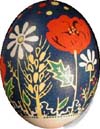

ONLINE BEGINNER CLASS

 |
 |
ONLINE BEGINNER CLASS |  |
| When did Pysanky have its beginnings? No one really knows
for sure. It is estimated that
the practice started well before Christianity came to the lands of
Ukraine, then known as Kyivan-Rus' (not Russia.) Some
experts estimate the art form to be many
thousands of years old. There were many ancient cultures in
what is now present
day Ukraine. For example, the Scythian people (4th Century BC)
are mentioned in the Bible (in the book of Colossians.) Much
older than the Scythians, was the Trypillian Culture (5400 -
2400 BC.) The Trypillian and other cultures in this part of
the world influenced the types of motifs, colors, and designs that
the ancient people "wrote" on their pysanky. Consider the
fact that designs used in the present day are often very ancient
designs. They have been handed down
throughout time, from mother to daughter, from grandparent to
grandchild, etc. Some
regions in Ukraine are very strict on how the designs are made,
and allow very little variation. Even today, one can
sometimes determine from where the artist came by the designs and
colors on his or her pysanky. During these pre-Christian pagan times, the egg alone
was a powerful symbol in its own right, because it contained the
essence of life. To write symbols and designs on the egg,
called the "pysanka," was to transform it into a talisman or good
luck charm, as the people may have felt powerless against the
forces of nature. Harsh weather, fire, or poor hunting could
result in starvation. Why not have a little extra
assurance? Surely, burying an egg, which depicted on its
shell a bountiful harvest in the wheat
field could do no harm? Or, perhaps depicting a rooster
would bring to the newly-wedded bride many children? Or,
many horses may bring
wealth and prosperity to someone in want? When Christianity
came to the peoples of Kyivan-Rus (by Prince Volodymyr, AD 988),
the people of Kyivan-Rus' simply transformed what were once pagan
symbols into Christian symbols. Thus, dots once representing
stars, now represented the tears of the Virgin Mary at the
Cross. Today, the highlight of the Christian Church calendar
is (as it has been since the birth of Christianity) Pascha (or
Passion of Christ.) The western Churches call this
"Easter." During the Lenten period of fasting, repentance,
and preparation for the coming Resurrection of Christ, "writing"
pysanky has been a tradition for many families. |
To learn
more about the Christianization of Ukraine, Trypillian Culture,
and other subjects,
CLICK
HERE to visit the Internet Encyclopedia of Ukraine.